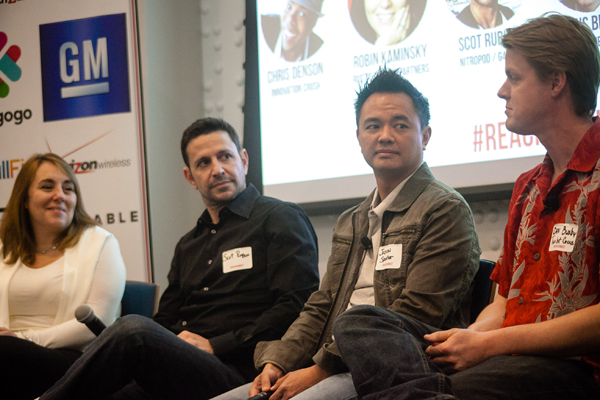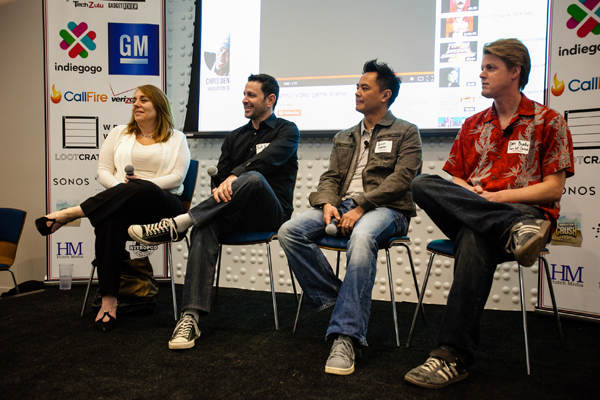REACH Connected Future: Gaming Recap
As you might recall, our first installation of REACH, was back in November and covered disruptive technology in the gaming industry. While gaming shared the stage with other industry tracks for last week’s event: REACH | The Connected Future, it was well represented through the insights of a varied panel of experts, covering a wide range of gaming’s different moving parts.
From investments and business, Robin Kaminsky, Entrepreneur in Residence at Rustin Canyon Partners, and former EVP of Publishing at Activision. Our builders included Jason Yim, CEO of Trigger Global; and Daniel Busby, Lead Engineer at Two Bit Circus; with Scot Rubin, Founder of G4TV and Nitropod, to represent media and consumers.
Moderated by Chris Denson of Innovation Crush, the discussion opens up with a big picture view of gaming, almost poetic with Dave and Busters as the setting.
Gaming at a Glance
Scot Rubin reflects a bit on how far things have come along. He points specifically to 1995, two decades ago, when consoles ruled the world and PC games were a tiny subset; but as we’ve seen the many faces of the gaming industry develop, we’re now looking at the wild success of virtual crystals, flight-indept birds; a world where free to play + micro-transaction models sit front and center.
But has the archetype for the hardcore gamer really changed from young males to moms and children? Robin Kaminsky, who’s spent extensive time in the investment and business world, says no. She says the money is still in the “traditional” hardcore gamers, the profile of younger boys and men. That’s where the scale is, she explains. This is of course, assuming we’re discussing console. The inspiration to create Call of Duty vs Clash of Cans is very different on mobile.
$$ and Advertisements
Concurrently, Scot also sees an overall pullback on original IP’s. As blockbuster releases have become more high profile, and so have their advertisement budgets. These same companies who are making huge bets on taking tv/online properties are also looking for new ways to increase their marketing budgets.
Jason jumps in on mobile – as his company, Trigger LLC does a lot in mobile and augmented reality:
He brings up how mobile has essentially been turned on its heads, and hints at games like Flappy Bird – with inexplicable growth. He alludes to work done for a pre-Superbowl mobile phone game which received a huge amount of investment and advertised like a traditional game.
Social Gaming
Gaming (especially mobile) is an inherently social experience. Not 100% perhaps, but mostly. Scot references Words with Friends, one of the defacto pioneers in the social gaming space. The panel warns us of the fine line gamemakers must walk when leveraging social gaming invitations. The difference between intriguing and obnoxious are actually quite close.
It’s hard to argue that social is where economic value lives. Robin brings up recent multi-player blockbuster Titan Fall and points to their strict online multiplayer only model. No single player, no storymode, no offline co-op. 100% social. The investment flocks to social because that’s where retention (or addiction) resides. Again, a fine line.
Social elements are also what get people to spend and stay. The panel argue, it’s not even necessarily the game itself.
Mixing History with Technology
We take a moment to focus on Daniel Busby’s work at Two-Bit Circus. Their company, focuses on physical experience, and is a far leftware departure from the gaming we’ve discussed thus far. The team at Two-Bit Circus makes use of the latest awesomsauce from the different arms of emerging technologies and dream up style arcade style midway games.
In fact, Daniel reports, they just did an install at another Dave and Buster’s location in the Irvine area. According to Daniel, their company viewpoint is that there’s a lot of money in social gaming. But that’s not what they do. They involve themselves in building games that require physical interaction – to keep peoples’ eyes on each other, not a screen.
The experimental, month-long installation at Dave and Buster’s Irvine can best be described as a virtual reality experiment. They tried different things, and truthfully, had no idea what would work, or what wouldn’t. End goal here? See if people are willing to pay for the experience that made use of the Oculus Rift headset, a virtual reality environment, and motion racing content.
In addition, they made the decision to maintain an unpolished, prototype look. A couple (hilarious) quotes on their findings:
- “Keep peoples’ expectations low and they’ll expect failure.”
- “It’s the appearance of hygiene that’s important” when asked if they cleaned the unit every time.
Shaping Consumer Behavior through Technology
Jason takes the floor to discuss some of the work they’re doing at Trigger.
Pertaining to virtual reality, his company works for brands by creating augmented reality applications. I infer Jason’s descriptions to be that his company is technology agnostic in order to mix real world game play with social capabilities. He describes a couple projects and their enabling tech:
- Nokia‘s Dragon Adventure game that utilized Nokia’s signature mapping technology. Kids playing the game could train their dragon depending on their location in the physical world. (ex: driving by a McDonalds would yield fatter, unhealthier sheep).
- Sesame Street – Featured as a text recognition app that could identify items in the grocery store and kitchen. Child gamers would “look for milk” and use their mobile devices to identify the physical item – thereby providing contextual and environmental learning, and making the process fun for children.
Their focus is on taking new, emerging technologies, and building from there. Their big driver is to find content that’s compelling, and in that way, lead behavior because no one else has tried it before.
The Other Side of the Coin
In a great inverse perspective to Trigger’s perspective to develop off new technologies, Two-Bit Circus pick simple, basic technologies first (camera + TV Monitors), then push the boundaries with how gamers interact; like their face swap installation that makes use of facial recognition and a basic screen.
Daniel claims their priority is on fun, not with market research. With their business, they rely on an intuitive, shoot from the hip creation process, then proceed their installations in front of young children and drunk people; which generally have the same level of cognitive abilities.
The audience laughs as Daniel assures us that the children, are never drunk.
Gaming, Behavior, and Needs
The panelists dive into an open floor discussion on the deeper, social dynamics of the gaming industry. Does technology drive how we behave? Or do humans dictate what we want? The panel agree that it’s a little bit of both:
“Technology pushes how we behave, but human needs remain intact.”
Diving Into Psychology
Robin brings up a compelling example to frame this discussion. When life simulation pioneer THE SIMS was on top of their game and copies were flying off the shelves, what was the most popular performed task? Sex. The panel drives deeper into human social-dynamics:
Going outside of gaming for a moment, we take a look at social dynamics prior to connection enabling technologies. Back then (eons ago), people weren’t as mobile and resided in self-contained communities. To excel in your particular craft, as a hunter, blacksmith, artisan, etc, was to prove you had a worthwhile reason to exist. Drawing parallels to today, with the world as large and connected as it is, accomplishment is just as important a reasons for being.
More specifically, gaming has become an outlet for personal accomplishment and importance (among other things) – by being the best sniper among your friends, or the most influential member of their clan. For younger gamers, it can be about acknowledgement, one of our most basic needs.
Moderator, Chris reminds us of stories of people whose lives were literally saved through acknowledgement, personal value, and the ability to make connections/friends within gaming communities.
On the Horizon
So what can we look forward to in the future of gaming? The panel describes new hardware dynamics as we move into the next generation of gaming (Google Glass, Oculus Rift v.2). Wearables are getting smaller, sleeker, and with smoother head tracking technology. Think immersive environments that are more fluid and that won’t get users motion sick.
Jason on mobile: He provides hints to new types of sensors (think mobile Kinect) and more accurate AR.
One Device to Rule Them All?
The pressing question on everyone’s mind: How close are we to whole, immersive environments, or a unified platform for gaming? Not really, our panel agrees:
- Scot reminds us that we have yet to see a majorly successful cross-platform project.
- Jason notes the work they’ve done for major companies like Lucas Films, and the need to focus on intensive development across multiple platforms – console, mobile, Kinect.
- Robin notes that technology-wise, we have the capabilities, but the problem is more a matter of platform volatility. Bluechip manufacturers want consumers to use only their technology, and she doesn’t see the “walled garden” coming down until a) consumers stop accepting it, or b) one of the walled garden players (Microsoft, Apple) decides to create applications across the entire board.
Closing the Panel
Our panel closes their discussion with their answers to describe the future of gaming (in one word):
“Fun, persistent, social, and connected.”















